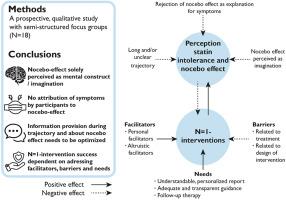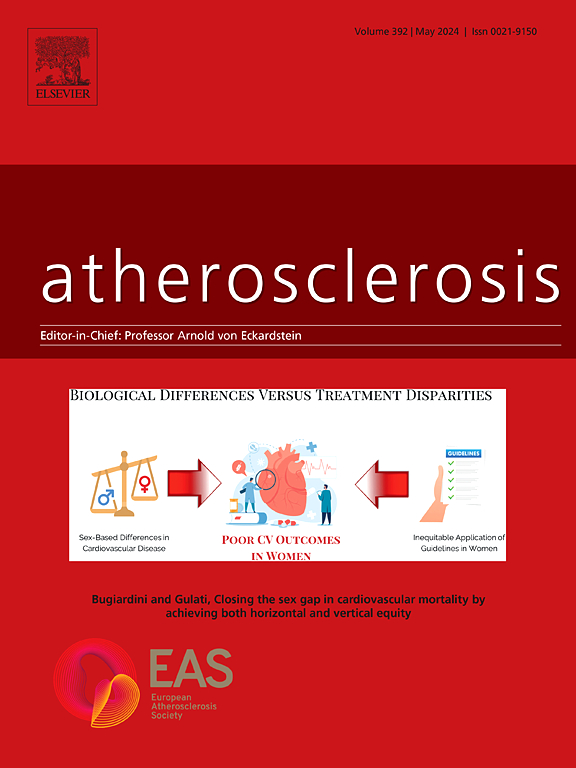患者对他汀类药物不耐受的看法,反安慰剂效应的归因和N=1干预措施的使用:一项定性焦点小组研究
IF 5.7
2区 医学
Q1 CARDIAC & CARDIOVASCULAR SYSTEMS
引用次数: 0
摘要
背景和目的他汀类药物相关症状经常在治疗期间发生,尽管N=1干预表明大多数症状可能不是治疗本身造成的,而可能与反安慰剂效应有关。本研究探讨了患者对他汀类药物不耐受、反安慰剂效应和影响参与N=1干预的因素的看法。方法对某大学医院的他汀类药物不耐受患者进行定性在线焦点小组调查。数据收集一直持续到数据饱和为止。按照专题分析的原则进行分析。结果18例患者(中位年龄65.5 [IQR 11.5]岁,56%为男性)参加了4个焦点组。虽然承认反安慰剂效应是一种主要由想象驱动的心理构造,但没有人将他们的症状归因于此。参与者将早期症状出现、严重程度、最初对他汀类药物的乐观态度以及停药后症状的缓解作为否定反安慰剂效应的理由。参与N=1干预的障碍包括对他汀类药物的不满意,对当前治疗的满意,安慰剂期脂质目标的不确定,以及对短治疗期可能不会引发症状的担忧。促进因素包括早期干预、利他主义、潜在的健康益处和研究重要性。患者强调需要明确的指导、个性化的结果、同伴比较、反安慰剂效应之外的原因沟通以及控制症状的治疗方案。结论他汀类药物不耐受患者认为反安慰剂效应与他们的症状无关,并感到信息不充分。关注反安慰剂效应的神经生物学成分,在患者早期引入N=1干预措施,结合个性化信息,包括实用的反安慰剂应对工具,可以促进N=1干预措施的参与。本文章由计算机程序翻译,如有差异,请以英文原文为准。

Patient perspectives on statin intolerance, attribution of the nocebo effect and use of N=1-interventions: a qualitative focus group study
Background and aims
Statin-associated symptoms often occur under therapy, though N=1-interventions suggest most symptoms may not be attributable to the therapy itself and might be related to the nocebo effect. This study explores patient perspectives on statin intolerance, the nocebo effect and factors influencing participation in N=1-interventions.
Methods
We conducted qualitative online focus groups among patients with statin intolerance from a university hospital. Collection of data persisted until data saturation was reached. Analysis was performed following the principles of thematic analysis.
Results
Eighteen patients (median age 65.5 [IQR 11.5] years; 56 % men) participated in four focus groups. While acknowledging the nocebo effect as a mental construct mainly driven by imagination, none attributed their symptoms to it. Participants cited early symptom onset, severity, initial optimism about statins, and symptom relief after discontinuation as reasons to dismiss the nocebo effect. Barriers to N=1-intervention participation included dissatisfaction with statins, contentment with current therapy, uncertainty about lipid goals during placebo phases, and concerns that short treatment periods might not trigger symptoms. Facilitators included early intervention, altruism, potential health benefits, and research importance. Patients emphasized the need for clear guidance, personalized results, peer comparison, communication on causes beyond the nocebo effect, and therapeutic options for managing symptoms.
Conclusions
Statin-intolerant patients perceive the nocebo effect as unrelated to their symptoms and feel inadequately informed. Focus on the neurobiological component of the nocebo effect and introduction of N=1-interventions early in the patient journey combined with personalized information including practical nocebo coping tools can facilitate participation in N=1-interventions.
求助全文
通过发布文献求助,成功后即可免费获取论文全文。
去求助
来源期刊

Atherosclerosis
医学-外周血管病
CiteScore
9.80
自引率
3.80%
发文量
1269
审稿时长
36 days
期刊介绍:
Atherosclerosis has an open access mirror journal Atherosclerosis: X, sharing the same aims and scope, editorial team, submission system and rigorous peer review.
Atherosclerosis brings together, from all sources, papers concerned with investigation on atherosclerosis, its risk factors and clinical manifestations. Atherosclerosis covers basic and translational, clinical and population research approaches to arterial and vascular biology and disease, as well as their risk factors including: disturbances of lipid and lipoprotein metabolism, diabetes and hypertension, thrombosis, and inflammation. The Editors are interested in original or review papers dealing with the pathogenesis, environmental, genetic and epigenetic basis, diagnosis or treatment of atherosclerosis and related diseases as well as their risk factors.
 求助内容:
求助内容: 应助结果提醒方式:
应助结果提醒方式:


